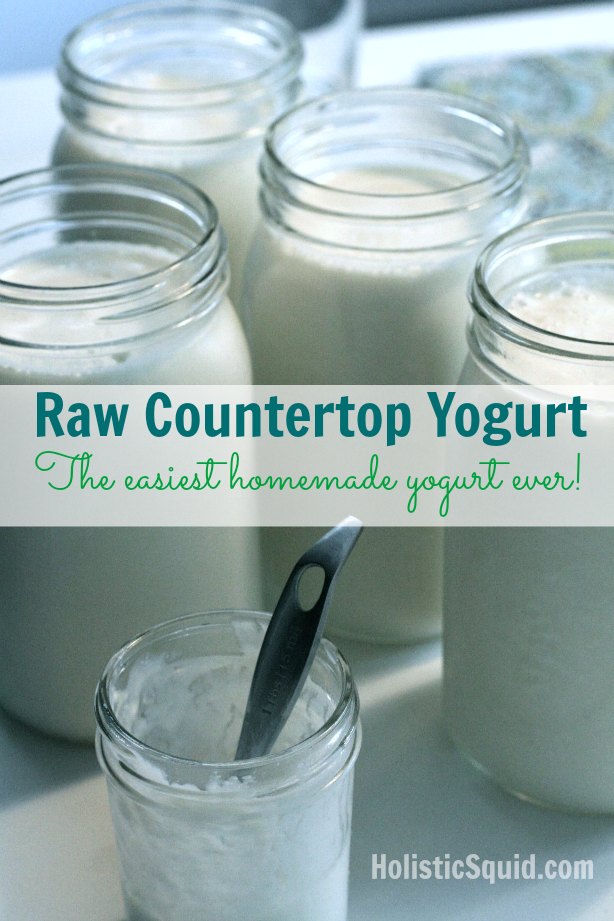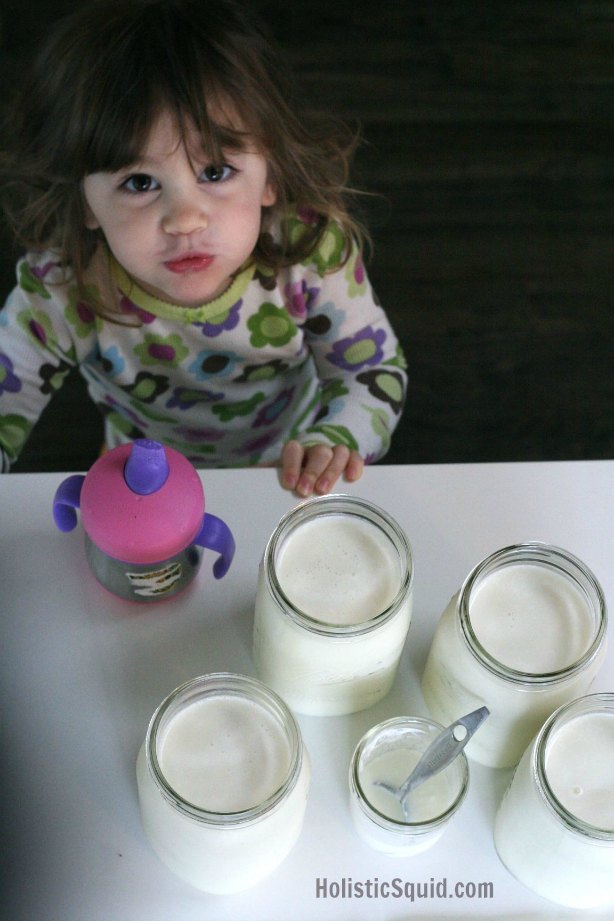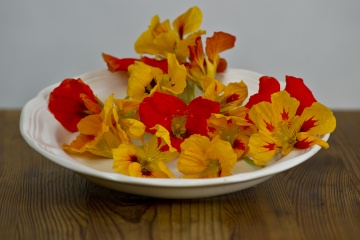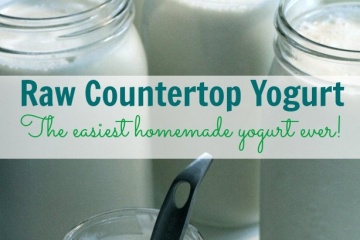
My quest for the easiest homemade yogurt is finally over. For a time, my favorite was this hybrid: half raw, half pasteurized yogurt made with milk and cream in a yogurt maker that yielded a consistently thicker yogurt than straight raw yogurt. But then along came Viili, a mesophillic starter culture that simplified my yogurt making for good.
With a mesophillic or room temperature starter culture, you don't need to figure out how to keep your milk warm while it's culturing. You simply let it sit on the countertop in a warm kitchen until the yogurt has set.
The consistency still isn't super thick like store-bought yogurts, but it's super easy to hang and thicken the yogurt if you're in the mood for Greek style or even yogurt cream cheese.

Ingredients and supplies for the easiest homemade yogurt
To make 1 cup starter culture and 1 quart of yogurt you will need:
- 1 packet of viili or another mesophillic starter culture – get yogurt starters here
- 5-6 cups raw milk (or a combination of milk and cream depending on how creamy you like your yogurt)
- 1 pint size glass jar
- 1 quart size glass jar
- a non-reactive saucepan
- a tablespoon
- 2 clean, dry cloths and 2 rubber bands for covering the jars
How to maintain yogurt starter culture using raw milk:
Place about 1-2 cups of milk in a small saucepan over medium high heat, just until the milk begins to rise up the side of the pot. Remove the pan from the heat and allow to cool. This pasteurizes the milk for the starter so that beneficial bacteria in the raw milk don't overtake the yogurt cultures.
When the milk has cooled to room temperature simply stir in your starter culture and allow to sit on the countertop for about 12 hours until the yogurt is set. Refrigerate.
You can then use this ‘mother' culture to make this week's yogurt and to make a new starter culture every week or so. If you keep up with maintaining your culture you can make yogurt infinitely from this original starter – never having to buy anything but milk!
How to make homemade raw countertop yogurt
Once you've made your starter culture, you're ready to make the easiest homemade yogurt.
Simply take 1 T. of starter culture and place it in a clean quart sized glass jar. Fill the jar with raw milk leaving about an inch of head space. Give it a stir, loosely cover it with a small bit of cloth secure with a rubber band.
Allow this to sit on the counter top over night (about 12 hours). In the morning, if you tip the jar you should notice that the milk has thickened into yogurt. If this has not happened, your kitchen may be too cool, so let it sit until it thickens – this may take up to 24 hours.
Transfer your yogurt to the fridge to cool and set, and you're done!
If you prefer a thicker yogurt, you can hang and drain the yogurt just like I demonstrate in this goat cheese post. If you hang it long enough, you will have a lovely cream cheese that you can spread on toast or cucumber slices. If you hang it too long, simply stir some whey back in to achieve your desired consistency.
Check out my first Holistic Squid video and watch me make the easiest homemade yogurt recipe!
Have you tried homemade countertop yogurt yet?












This is the type I use. EASIEST THING EVER! Haven’t tried it with raw milk yet. But you can literally mix it up in less than a minute. I make 1/2 gallon several times per week. 🙂
What do you do with so much yogurt? I’m so impressed by the recipe but are y’all just eating it like a snack or treat thru the week ?
I make 2-4 quarts a week of regular yogurt (I just incubate and use previous batches as a starter…much easier than this since I just zap the milk in the microwave for 21 minutes- I have a low wattage microwave- come back in 1.5-2h stir in 3 tbs of previous yogurt and leave overnight in my incubator. Actually is much easier than this countertop method. Once you figure out the heating time it’s pretty error free and standardized.) It is pretty well known that fermented and cultured products are essential in healthy gut flora. Civilizations have been considering yogurt a medicine or health food for years since it pretty much eliminates a lot of common stomach problems. Some even considered it ‘mana’ or a food with magical properties. Yogurt shouldn’t be considered a ‘treat’ when it’s essential to some. (ask anyone with paralyzed portions of their digestive tract).
Also if you live in a warm climate you can incubate regular yogurt on your countertop anyway. People think it’s super critical to have a specific temp for everything but honestly people have been doing it without thermometers, incubators or fancy equipment for lifetimes. Yogurt also provides the benefit of dairy fats without the lactose (It reduces the sugar content of milk if you incubate long enough). It is really a superfood. Calling it a ‘treat’ makes me cringe.
Just saying you Put milk in the microwave makes me cringe..
Me too!!
Me three! I do not own and never will own a microwave. Microwaving food destroys phytonutrients.
Meeee 4!!! Pls don’t microwave your milk that you are making into yogurt.. All that good stuff you mentioned.. Totally a moot point since you nuked the precious live enzymes and bacteria.!!! Sad sad sad!
How long does the batch of starter last in the fridge? I’m guessing that one batch of starter can make lots of yogurt?
wondering the same thing because I don’t want to waste the raw starter and the expensive starter culture. Also, can I separate them into 4 oz jars? It would be easier for the kids to eat like that and give them the feel that they are eating store bought yogurt that mommy made. 🙂
Hi Dee – Thanks for your question. Every week you need to make a new starter as I demonstrate in the video, but instead of adding the powdered starter, you add a tablespoon of last week’s starter. Hope this helps!
Hi Emily. Great post, and thanks for the video. I haven’t tried making my own yogurt yet, but I think I can start now. You mention that you can use the mother culture to keep making yogurt week after week, if you maintain it properly. Can you tell me how this works exactly? Do you use some of the yogurt that you’ve made to add to a new quart of raw milk each time, or is there something more to it? Thanks!
Hi Jenn, thanks for the question. No, every week you need to make a new starter as I demonstrate in the video, but instead of adding the powdered starter, you add a tablespoon of last week’s starter. Hope this helps!
So you make the whole thing of starter, the first time with the culture packet, only one tablespoon of the week priors starter after that and then toss the rest because it won’t keep?
Hi there. This seems awesome considering I have a hard time with making traditional yogurt. My concern is that I don’t have access o raw milk. So can I used whole organic milk the same way? Your tips would be greatly appreciated. Thanks!
Hi Tami, thanks for the question! Sure, you can make mesophillic yogurt with pasteurized milk as well. Enjoy!
Can I add fresh fruit or vanilla to this without hurting the integrity of the yogurt?
Hi Sara, thanks for the question. I’d do this after culturing for the best results.
Great video!! Thank you! Question…I see that you heat the raw milk to make the starter, but do you have to heat the milk that you add the starter to? Thank you, looking forward to trying this! YUM!!
Hi Heather,
Thanks for the question! Nope! The milk for the yogurt is raw. Enjoy it!
Great job, Em! You did an AMAZING job! Cant wait to try this yogurt!!!
Love the video! When you use the “mother” culture to make a new starter, how much of the “mother” do you use in place of the original starter culture packet? I’m assuming you just eat the leftover “mother” once you’ve made the “new” starter…??? I’m excited; this looks so easy! Thanks!
Hi Amanda,
Thanks for the question! It really is super easy! I usually use a tablespoon of the mother to make the new starter even though it’s a smaller jar – you could probably use less. And yes, if there’s left over starter you could definitely eat it. Enjoy!
Hi! Just thought I’d chime in as to some of the questions since I’ve been using Cultures for Health Yogurt for a long time and have maintained a mother culture successfully–really is a great company. You need to make a new mother culture each week (ish)—this of that is what you are feeding your yogurt rather than yourself. So you start off by making a mother culture, then use a portion of that to make your first batch of yogurt and hang on to it because you’ll use the rest next week to make a new mother culture. CFH has a huge free ebook explaining it. You can use any animal milk to make it, but raw milk and goat milk will yield a thinner yogurt. Organic whole milk will be a perfectly fine and actually thicker than the raw, but make sure it doesn’t say “ultrapasturized.”
There are different strains you can buy–the one she has here is “mesophilic” meaning–“eh, I’m impartial to temperature” whereas “thermophilic” means “I like to be warm!” If you get the thermophilic (heather) you would have to heat the milk, but if you have “mesophilic” you don’t need to heat it! The one disadvantage to meso is I think its supposed to be thinner, but haven’t used it personally–it’s for sure easier though because you don’t have to worry about maintaining that 100 degree temp!
So is pasteurised OK as long as it’s not ultra-pasteurised? Sorry if that’s a stupid question, but I’d really like to try this out – am currently buying shop bought yogurt and it’s full of so much rubbish.
Hi Rachel, thanks for your question. Pasteurised is fine if that’s all you have access to. Try and stay away from ultra-pasteurised altogether.
Rachel-it’s ok, it is a little confusing. You can really use any milk as long as it’s from an animal and not in powder form. Raw milk is optimal in that you can just heat to 110 (or in this case room temp!) and preserve all the enzymes & bacteria. Yay. But not practical for everyone. Pasturzied milk has been heated to 160 which kills all the bacteria & denatures some of the protein. That’s less than optimal, but still ok–since you’re reintroducing good bacteria, they will proliferate. The problem with ultra pasturized is it is heated up to 280! Yikes-that’s crazy high-killing about everything good in there for ya–much of the commercial organic milk is UP probably because it’s expensive & gives a nice long shelf life. I actually believe that UP preserves the milk well enough that it doesn’t even need to be refrigerated, they just do it because people won’t buy milk on the shelf. It should still work, but it’s sort of like trying to revitalize something that has had all the nutrition scortched out of it. That’s the way I understand it 🙂
Great post. The video was very helpful. I look forward to trying i.t. Thanks.
what is a non reactive pan?
Hi Susanna, thanks for your question! Stainless steel, clay, enamel, or glass are all non-reactive. A reactive pan is one made from a material that reacts chemically with other foods, such as aluminum, copper and cast iron. Hope that helps!
Can you use almond milk?
I’d like to know about this too! We have a severe dairy allergy in our family and to make homemade almond yogurt or coconut yogurt would be amazing!
Could I use coconut milk? As much as I like dairy yogurt, it makes me sick and my son can’t have animal milk in any way, shape or form. Or, do you need a different type of starter to culture non-animal “milks”?
Viili really is super easy! Even easier than the article explains, but maybe I’m doing it wrong. I was lucky enough to just get some viili yogurt in a jar from someone I know. Then, before it’s all gone, I dump some in a new jar with some raw milk. Once that ferments I have a fresh jar to eat, always saving a little bit to make more. Usually I like to have two jars just in case one spoils for some reason.
I don’t even measure – a few times I’ve made a new batch with just the remnants sticking to the old jar, filling it with milk.
A note, though – viili has a slightly different flavor and texture than most yogurt. Still works great in smoothies etc. but takes (for me, anyway) a little getting used to for eating plain. Maybe the other mesophilic yogurts are different? I don’t know.
To safely make raw milk yogurt, You HAVE to keep a mother culture that has been pasteurized or else you are allowing bacteria to grow in your raw milk yogurt that could be harmful to you.
So…the “Mother” takes the place of the powdered starter culture in future batches? When you make a new “Mother,” you take a Tbsp from the previous “Mother” and add to a new pint of pasteurized milk? So simple, yet so confusing!
I love making yogurt, but have never tried raw, this looks like something I definitely want to try
I have to be honest, I didn’t like the flavor of the viili yogurt, plus it was really super thin. The flavor was tart. I tried another of the counter top yogurts and didn’t care for it much either. I also found it very difficult to maintain the correct temperature for the counter top yogurts (no a/c) and every person I shared a culture with killed it within a week. even tried making it in a cooler to control temperature a bit better. I guess I’m just a thermophilic yogurt type person. 😉 Much easier to come by to start new batches too since it can be bought in pretty much every grocery store. 🙂
Yay! I cannot wait to try it. I’ve been making thermophillic, but I love the ease of this method!
Thanks!
Jen
I’m going to give this a go! I’ve had success in the past with pasteurized milk but not so much when I try with raw. It’s either very runny or it separates (fermented too long, I believe) Raw milk is too expensive to end up with 3/4 of it as whey! Bookmarking….Thank you!
sherri
Iv been making my own yoghurt using a tablespoon of store brought stuff, topping it up with milk straight from the cow and leaving it for 12 hours in my yoghurt maker.. perfect everytime!
Can you please clarify why you make such a large yogurt starter culture if you only wind up using 1 tbsp of it? What do you do with the remaining yogurt starter culture? Did I read it correctly in an above post that you say you just drink it?
Hi Sara, thank you for your question…you can eat it, but i usually make several quarts of yogurt and a big batch of homemade cheese, so it’s just enough for me.
I wondered about this type of counter top yogurt. After watching the video, it doesn’t appear to be much different looking and tasting than my Bulgarian yogurt from raw milk; actually Mother Linda’s. The difference is I don’t make the mother culture by pasteurizing, just add the Bulgarian (Natren’s powdered) to raw milk heated to no hotter than 110. Then culture it for about 12 hours in my oven with the oven light on which never gets hotter than 90. It is thin, tart and perfect for drinking like keifer or to make a smoothy but you sure can’t spoon it! Mother Linda says that taking raw milk, heating it super slow to 180 then cooling, adding the Bulgarian culture then culturing it for 12 hours at 110 or lower, makes the best yogurt and I have to agree. I still strain it, save the whey of course for other lacto-ferments, and it’s spoonable. I’ve tried it so many ways with so many milks and hers is the best ever. Also, from what I’ve read, make yogurt at least every two weeks, not a bunch to last months. The probiotics and antibiotic affects are strongest the first week and after the second week, not so much. That is from Max Aldt and his books from the 1970’s.
I love yogurt!!
My son, his family and I eat yogurt for breakfast mixed with fresh fruit, huge improvement over the boxed cereal they had been eating. I’ve been making yogurt for about 6 months, and it’s become a weekly routine. One gallon of milk in a stainless steel pot, heat to 180-200 and keep at that temperature for at least 1/2 hour. Remove from heat and when temperature is cooled down to between 100 and 110 degrees, mix in about 1/2 -3/4 cup reserved yogurt from prior batch. Pour into four quart jars attach lids and place in oven with light on. After about 12 hours it’s time to let cool and place in refrigerator for a day. The yogurt is thick as regular store brands, but for Greek style or yogurt cheese I strain using an Exoglass Bouillon Strainer, it wasn’t cheap but much cleaner to use than cheesecloth. The whey is used for fermenting vegetables and in our fruit smoothies (also mix a little in with the cat’s food).
The starter link you included is unavailable…is Villi the same as mesophilic? Would these work?
http://www.amazon.com/Mesophilic-C101-5-Packets/dp/B0064OLJZ6/ref=sr_1_1?ie=UTF8&qid=1389049468&sr=8-1&keywords=mesophilic+culture
Hi Jill – Thank you for catching that. I have updated it with another starter culture that I like. Hope that helps!
Thanks Emily 🙂
Our raw milk comes with a lot of cream on top. If I skim off the cream to use to make other things (butter, sour cream, etc), will it still be considered “whole milk” yogurt or does it need the cream?
Hi! Thank you for sharing this. I can’t wait to try it. Can I get whey from this homemade yogurt?
Hi Crystal – Yes. You can hang it to drain, and the whey that drips out of it can be used for fermenting.
You used 1-2 cups of raw milk, pasteurized it, put in the starter and then only used 1 tbsp of the mixture. What did you do with the rest? Can I not just make a tablespoon of the mixture in the first place, so as not to waster raw milk?
Hi Kevin – Thanks for your question. You can use this ‘mother’ culture to make the yogurt and to make a new starter culture every week or so. If you keep up with maintaining your culture you can make yogurt infinitely from this original starter, so it won’t go to waste. Hope that helps!
When you refresh the starter by adding more cooled pasteurized milk each week, do you need to let it sit out on the counter for 12 hours again or do you put it directly in the fridge after you add the new milk?
Hello,
We’re following the GAPS Intro. and are needing to make 24 hour yogurt. I really need to make some soon, so was wondering if I could just use yogurt starter from an organic commercial yogurt instead of the powder and leave it out for 24 hours?
Hi Jennifer, unfortunately the method you describe will not work. There are two ways to make yogurt in this way – thermophyllic (heating in order to achieve results) and mesophyllic (room temperature). This recipe is a mesophyllic recipe, which is why you need the starter culture in powder form. If you wanted to do it without the starter, you would have to use a thermophyllic method instead. I hope this helps.
Each week you use 1 Tbsp of your mother culture to make the next culture. So the culture only lass about 1 week? And how do you know when you need to start from scratch with a new viili packet?
Hi Rebecca, this really depends on how many jars you’re making. In theory, you shouldn’t need to start from scratch with a new viili packet. On the other hand, if you go on vacation it could go bad and then you’ll have to start again.
WHERE DO I BUY RAW MILK????PLEASE!!!!!
CAN I ONLY USE RAW MILK? HOW ABOUT NON_HOMOGENIZED, SLIGHTLY PASTEURIZED FROM MOM’S?
Can’t wait to try it!!!! Thank you!!!!
Hi Mari, usually best to see if one of your local farmers can supply it to you. If you can’t get, the non-homogenized milk will work.
Check out realmilk.com
Thanks so much for this post. The amazon link shows the culture is for cheese? Is this the right one?
Yes, the culture is the same – thanks Michele.
I look forward to trying this! In the comments you mention that you use the mother culture for homemade cheese. I have your homemade goat cheese recipe, and was wondering, after I make the first batch of mother culture, how much of this mother culture would you use to replace the the “mesophilic culture for cheesemaking” in the recipe? Thank you!
My grandfather used to eat some for lunch almost everyday. He used regular milk and let it sit on the table for about 5-6 hours. He lived to 86. No starter kit or anything. What was it???